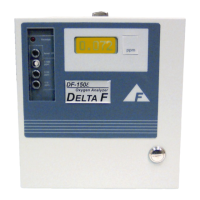
Do you have a question about the Servomex DF-150E and is the answer not in the manual?
| Brand | Servomex |
|---|---|
| Model | DF-150E |
| Category | Analytical Instruments |
| Language | English |
Instructions for unpacking the analyzer and verifying contents.
Defines symbols used for warnings and important notes in the manual.
Critical safety alerts including DANGER and CAUTION notices.
Details measurement ranges for DF-130E and DF-150E models.
Information on the analyzer's reaction speed to O2 changes.
Specifications outlining the analyzer's measurement precision.
Lists compatible gases for standard and special sensors.
Specifies gas conditions: phase, temperature, flow rate, and pressure.
Defines the acceptable ambient operating temperature range.
Provides the analyzer's physical size and weight specifications.
Notes on storage, operation, power, and certifications.
Step-by-step guide to filling the sensor with electrolyte.
Instructions for connecting sample gas lines to the analyzer.
Guidance for connecting analog and digital output signals.
Procedures for safely turning on the analyzer.
Overview of optional features and their functionalities.
Information on maintaining consistent calibration over time.
Explains the indicator for electrolyte level and contamination status.
Details default and alternate analog output voltage settings.
Option to enhance sensor resistance to acid gases.
Configuration and adjustment of alarm set points and relays.
Information on optional pressure regulators for sample gas.
Details on the gas sample particle filter and elements.
Description of the visual low flow indicator feature.
How the low flow alarm functions and its impact.
Information on the flow control valve for pressure regulation.
Option for using stainless steel tubing for specific applications.
Details on the on-board pump for vacuum or low pressure operation.
Methods for controlling the analyzer's pump.
Technical specifications for the 4-20 mA isolated output.
How to correct readings for different background gases.
Recommended ranges for sample pressure, flow, and temperature.
Precautions against moisture and liquid ingress into the sensor.
Guidelines for maintaining optimal sample gas temperature.
Importance of leak-free systems and leak detection methods.
Effects of exposure to high oxygen concentrations on the sensor.
How acidic gases interact with the sensor's electrolyte.
Pinout and functions of the Input/Output connector.
Details on alarm relay configurations and operation.
How combined alarms indicate a system issue.
Relay specifications for non-CE certified units.
Relay specifications for CE certified units.
Technical specifications for the 4-20 mA isolated output.
Information on analog output terminals and signal scaling.
Functionality for scaling readings on remote devices.
How the Sensor Off switch protects against over-range conditions.
Pinout diagram for connecting remote sensors.
Details of the connector used for pump control.
Methods for controlling the analyzer's pump.
Connecting and controlling external pumps via the analyzer.
Utilizing a remote switch for on-board pump operation.
Routine care for the oxygen sensor, including electrolyte checks.
Step-by-step guide to refilling the sensor's electrolyte.
Information on initial calibration and periodic span checks.
Procedures for performing span and zero calibration adjustments.
Instructions for cleaning the exterior surfaces of the unit.
Diagram illustrating the electrochemical process of the oxygen sensor.
A guide to identify common issues and their recommended solutions.
Lists typical analyzer issues and corresponding actions.
Detailed explanations of troubleshooting actions and checks.
Factors influencing performance and troubleshooting.
How gas pressure impacts analyzer accuracy and tubing selection.
Guidelines for managing flow and pressure in positive pressure systems.
Guidelines for managing flow and pressure in negative pressure systems.
How temperature variations influence sensor readings and drift.
How flow rate variations influence sensor readings and calibration.
A list of common parts that can be replaced.
Instructions and safety precautions for replacing fuses.
Procedure to safely remove electrolyte from the sensor before shipping.
Steps for correctly re-installing the sensor after maintenance.
General warnings about electrical hazards and chemical handling.
Key operational points like sensor charging and over-range protection.
Broad safety advice regarding environmental conditions and operation.
Detailed safety data for the electrolyte solution.
Safety information for the sensor replenishment solution.